If the International Theatre Festival in Pilsen was a human being, s/he would be dressed in an unassuming manner, yet elegantly and with flawless taste. S/he would be one of those industrious people who do not show off their work but quietly build long-lasting creations—people who do not waste their time, since they know somehow by birth what is substantial in life, and the very communication with them makes you wiser and harmonized.
I’ve attended the Pilsen Festival many times – since 1997, when it was still a toddler – and I’ve always come back home with the joy of discovery: of a director, show, company… Still, its 26th edition brought me even more than that. Many months have passed already and I still keep on getting back to it. And not only in lectures and professional talks but in essential life situations – it helps me rethink them and see the substance behind the appearances. As if I keep on communicating with it – on some invisible level. Again as with those people of whom it reminds me – you may not see them often, yet their natural integrity, their so rare today radiance of inner peace and calm, keeps on charging you and even sort of centering you, regardless of the time and distances.
Most festivals today hardly manage to resist the temptation of many-ness and the related to it illusion that by being constantly on the run we will manage to do/see/have everything. And they become a continuation of the chaos we live in – of the haste as a mode of life and the ensuing bitter feeling of frustration, a feeling of being losers. For, naturally, we are not able to cope up with everything, at least not as fully as we wish. And, instead, we surf not only in the net but on the surface of our life. In brief, most festivals, exactly like us, humans, often fail in the making of the right choice and in mastering the skill of not using figures as an indicator of quality. Even the themed festivals rarely manage to do so – to concentrate.
Unlike the Pilsen Theatre Festival where the key phrase was ‘a lack of excesses’ and the key word integrity.
For this reason, it resembled not only a certain type of people but a piece of high-class literature, too. The choice and the arrangement of its program were so precise, done with such flair for homogeneity, that every next-show continued as if part of the previous one – exactly like a book chapter adds to and develops the already-narrated. United in this case by one common thing: their concentration on “the ultimate purpose of the few brief moments that pass between birth and death,” if I may quote the famous line of Jan Kott, written about Shakespeare. Very naturally, at the bottom of this search for the meaning of life, and of death as part of it, the theme of making a choice for the road between them was central.
“We will die/Today or tomorrow/Life is what we borrow.” This final song of The Iliad – the first show in the program (directed by the Slovenian Jernej Lorenci) – was like a tuning fork which set the tune of the whole Festival. And what preceded the song were some of those rare hours when theatre reminds us of its most important mission: to lift up the invisible curtains before our eyes so that we can see through into the immaterial and get an insight for the essence of our seemingly only material world and life.
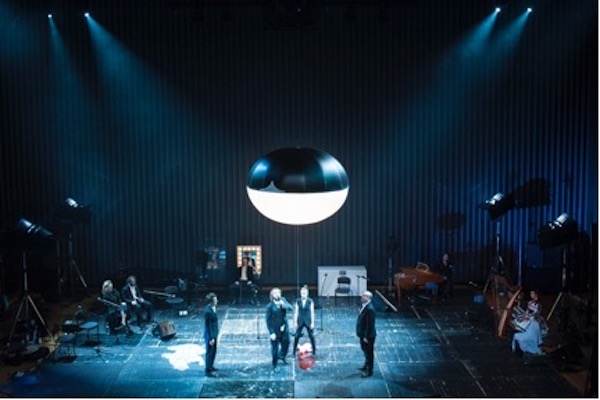
The Iliad. Photo Credit: Peter Uhan.
The Iliad states that it would be exactly about this with its very first gesture: a typically Balkan pouring out of alcohol on the earth/floor, as a way to pay homage to the dead. This is a gesture which gets repeated again and again throughout the show: by the narrator of the story – so to speak, the stage Homer – and by the main characters – people and gods. All of them, sitting on chairs, facing the audience (a typical mise-en-scene of Lorenci), with mikes in front of them. These mikes are not there just to amplify their voices when they pronounce or sing the words of the well-known Trojan-war heroes. Equally importantly: it’s with them that the very rumble of the war gets created, the clatter of hoofs, the flight of its 10 pointless years… And this is done only via a very slight finger-tapping at that – in a different rhythm depending on the scene. This stunningly simple “trick,” along with the mighty rhythm of Homer’s hexameter and some brief ‘interventions’ of music, played live on harp, piano and rebec, create an extraordinary epic feeling. And since there are no special visual effects – i.e. there is nothing to curb the audience’s imagination – the epic becomes even more palpable.

The Iliad. Photo Credit: Peter Uhan.
However, the goal of this Iliad is not to have the audience’s imagination draw epic scenes. The epic here is, so to speak, on a vertical scale. For the impact of this piece of theatre comes to a large extent from the sound frequencies which attune the audience to special waves, as music does, and transports it into other-worldly dimensions.
The resulting nearly metaphysical transformation was one of the specialties of the late Lithuanian director Eimuntas Nekrosius – although in his theatre there was a larger ‘dose’ of pure material on stage. A great master of it is also the Polish Grzerorz Bral, with his Song of the Goat Company, who is even closer to Lorenci in creating theatre with no sets and nearly no props, and who is at times able to lead his audience even further ahead into the territory of the invisible. I call this type of theatre vertical. It strongly resists the dictate of materialism and superficiality of our time and catapults us high or deep (depending on the view-point) inside us where with “the eyes of our heart” we are able by birth to see what is good and what not. And the ultimate achievement of this vertical theatre is that it reminds us exactly of this innate gift of ours to be able to tell this most important difference.
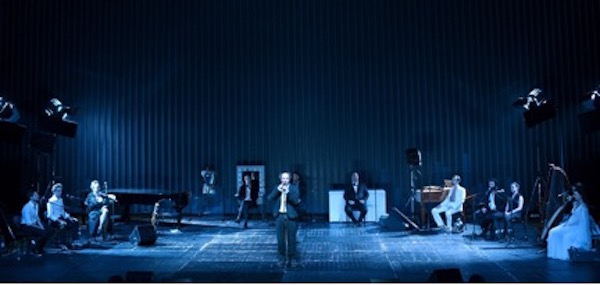
The Iliad. Photo Credit: Peter Uhan.
In the case of Lorenci, as it is with his co-patriot Tomi Janezic, there is usually a ‘pinch’ of flesh on stage. Only for an accent, though. In The Iliad, Lorenci puts a real animal corpse on stage, as if taken right from a butchery shop: it’s this corpse that Achilles fiercely beats, albeit just a pile of meat left from the human being whom he punishes for the death of Patroclus. This scene feels like a quintessence of the vicious circle of vengeance, when people, possessed and enraged, start mindlessly killing each other.
And one more remarkable accent: at the end of the first part, Achilles’ mother, appearing as a vision, outlines the two possible roads in front of her son – a short life and immortal death or a long life without any trace of him left afterwards. Fully appropriate to the modern nuance of this choice and the road we know he will opt for, Achilles sits at this moment in front of a bulb-framed mirror, as in a modern dressing room. After she disappears, he remains there, alone and silent, against the background of the rhythm created by the narrator on the mike – now as if the fading echo of the sorrow in his mother’s voice and, in her face, of an invisible Chorus who tries to guide people, blind for the right road from days of yore.
Another Festival show where the sound played a major, even in this case, lead role was Rooms after People of the German Rimini Protokoll and the Swiss Theatre de Vidy. The sound here is only of the human voice – even without the presence of the very people to whom it belongs, or used to belong. Recorded when they have understood that they are to die, have chosen to do so, or expect that this may happen any moment. And they talk to those others who are to stay after them, telling them what their lives were like, why and whom they’d like to leave their objects or just memories, how they’d like to be remembered, whether or not they believe there’s something waiting for them in the beyond.
Voices, words, stories – 100% real, recorded and edited by the German masters of the documentary-based theatre. Their voices resound in eight rooms, among objects having belonged to the respective people and in milieus that used to surround them. (The audience enters there from a small foyer in groups of five.) The face of only one of the people could be seen – in a visual message he recorded, the most cheerful of all: a Turkish gastarbeiter who, albeit still in good health, arranges his future funeral in Istanbul. The others? A severely ill woman having opted for euthanasia. A former diplomat who has left all she has to artists in Africa, where she used to work. An elderly couple who, along with their money, wants to bequeath also the wisdom learned from the many lessons during a long life. A relatively young man who has discovered too late he has a genetic decease and wants to tell this to his son. A fan of extreme sports who expects every time he goes jumping from a rock that it will be the last one (maybe one of the few still alive heroes of this piece). An elderly woman, content with her long and meaningful life, who has put piles of photos of her huge family on a round table in her old-fashioned, cozy room. A professor who holds no doubt there is nothing after death.
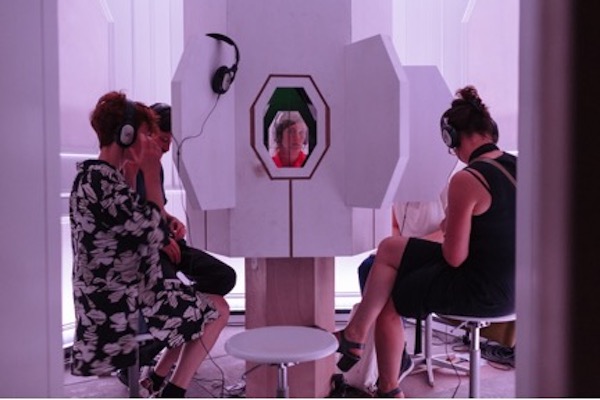
Rooms After People. Photo Credit: Rimini Protokoll.
After funerals the world looks and feels different and at least for a short while we get to be wiser. After this unique theatre-installation experience one feels set up on a philosophical wave for much longer, maybe for the lack of the personal-pain factor here. Or maybe simply because it’s not the encounter with death that changes the viewpoint towards life in Rooms after People but something totally different that we very seldom think about: the border territory between the visible and invisible. Since isn’t the human voice one of its dwellers or even sort of a medium between these two worlds? The human voice which, albeit coming out of the body, has at times something other-worldly to it – something from the unchangeable world of the spirit? Not by chance have Chinese traditional musicians always had to first get appeased from within and fully harmonized before producing a sound – with their voices or instruments – for only in this way could they become mediums for the divine harmony.
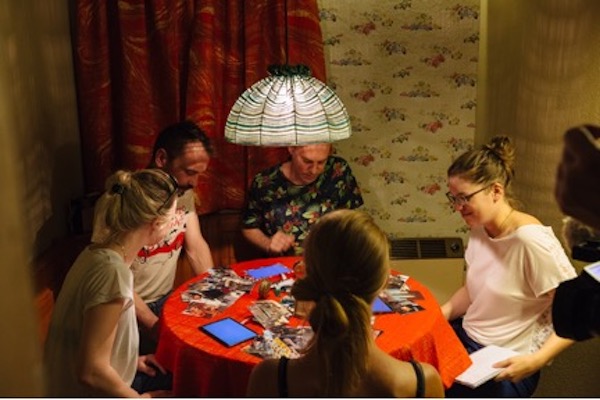
Rooms After People. Photo Credit: Rimini Protokoll.
The Rimini Protokoll production evoked in me the memory of a voice: of my husband, ten days before he left this world. His body was so frail that he needed two people to help him stay on his feet on a stage during an important centenary celebration, yet his voice was ringing as it did when I had first heard him. Exactly as if it was coming from another world which was keeping his body alive to see this event happen.
Of course, despite all its remarkable philosophical depth and the infinite realm of the spirit that Rooms after People gives us a chance to get a glimpse into, after it one can ask a very sobering-down question: what about all those other people for whom a calm preparation for the transition to the beyond is an unthinkable luxury? If there is a minus in this production, it’s that the world it presents is only the part of Europe that can afford this luxury.
About some of the other people – the ones for whom life is something they borrow under very difficult conditions while paying back the credit – was the final production of the Festival’s program: Imitation of Life, directed by the Hungarian Kórnel Mundruczó, at the Proton Theatre, Budapest. It was also about something unseen.
In the beginning, on a screen above the front of the stage, there is a close-up of the tired face of a middle-aged woman who is fervently arguing with somebody whom we don’t see, in a desperate attempt to preserve her dignity. Gradually it becomes clear that she’s been chased out of the flat she lives in and that it’s not the first time she is driven into a corner. Only because she is a gypsy! From the bits and pieces of stories she throws in, as if to barricade herself behind them, it becomes also clear that her life is indeed more of ‘an imitation of life.’ There is only one detail: a routine forceful bathing with pesticides… The screen goes up and what the audience sees is a spacious double room with a portal in an old high-ceiling apartment and high French windows with arches – at once a kitchen, a living room and a bedroom. The woman sits at the table there, together with a liquidator who has come to chase her out. The conversation goes on only for a short while and she faints.

Imitation of Life. Photo Credit: Proton Theatre.
What follows is the next, so to speak, ‘block’ of the show. For Imitation of Life is built on the principle of a very brave montage of big and distinctly different fragments/episodes without smooth transitions between them, as if it’s a large-scale telegram, written not with words but with images and sound, yet with the typical laconic, concise and cut-to-the essence manner. The liquidator calls an ambulance and the discrimination story continues: they don’t want to send one into this neighborhood. The room ‘disappears’ again – now behind a curtain of fog which starts literally streaming down from the upper front of the ceiling, forming a fourth wall – while on screens aside of it the audience can read the lines of the ER operator. Then a projection on the fog itself starts: footage from the hotel where, as we have already learned, the son of the flat’s tenant works as a prostitute. We now see him and the feeling is ghost-like. The fog curtain is like a waterfall – in constant movement, in thick and thin streams, and at times in waves. This uneven and alive, airy ‘screen,’ which can be seen but not touched, makes for an amazing effect: the boy is deceptively three-dimensional, like a mirage or hallucination – exactly like the illusory life he has chosen to live.
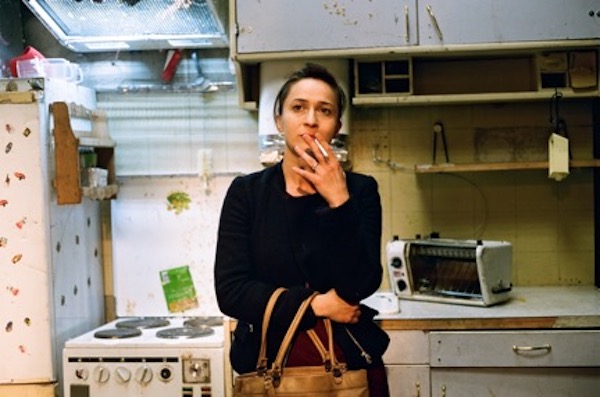
Imitation of Life. Photo Credit: Proton Theatre.
It’s not only in this scene but throughout the whole show that the subtext is not in-between the lines, but in such stunning stage-language metaphors. That’s why, without being at all didactic, Imitation of Life manages to keep a high moral note without a miss, and is charged with a very strong social message.
Its essence – as well as of the unique stage language of Mundruczó – is the next scene (‘block’), which is without any words and without actors, lasts over ten minutes and is something that, I believe, happens for the first time in theatre. The fog disappears and the room is again on stage, this time without anyone inside. A creaking sound resounds and this very large room with all the huge abundance of objects in it starts very slowly to turn upside-down, in an opposite-to-the-clock direction. First the small objects start falling. Their uneven clinking gradually grows into a deafening rattle, when the big objects start crashing down and breaking apart. And, when the floor becomes a ceiling, some of the big kitchen appliances fall down too. The effect is astounding: as if we have witnessed a giant earthquake or hurricane, or even more than that – a tectonic cataclysm.
When the room goes back to its initial position, the liquidator enters again together with a new, this time young female tenant. And as if nothing has happened, the ‘imitation of life’ continues. It continues even in that the chaos doesn’t at all impress, neither the liquidator, not the new tenant. As soon as he leaves, she calls her young son, who’s been hiding out, to come in (the contract stipulates that she should live alone), they make the only surviving bed and when the child goes to sleep, she puts on a short, vulgar type of a dress, exchanges a few text- messages and, ready for ‘work,’ leaves into the night. What follows is a very short scene: the son of the former tenant comes in and finds out from the child that his mother is dead. Then the screen again is in front of the stage and a piece of news can be read on it: the son-prostitute in question killed someone in a bus; the incident stirred up a wave of protests. End.
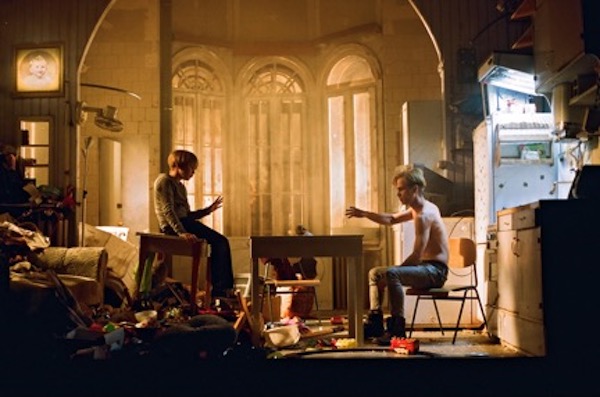
Imitation of Life. Photo Credit: Proton Theatre.
It’s only at this last moment when it becomes clear that Imitation of Life has a documentary spring-board. Nearly fourteen years after another news-inspired show – Black Land created by director Arpad Schilling and his Krétakör Theatre, which traveled the world over, shocking its audiences – another Hungarian makes the stage scream out of pain for the state of humanity today and attempts to shake us out of our stupor. Mundruczó doesn’t apply the direct and deliberately provocative language of the political variety-show, which was so well used by Schilling, but his unusual image-and-sensory-experience rich theatre ‘telegram’ sends, in effect, the same type of an SOS. And again to all of us, as an addressee. Also, his show in a special way feels like returning the echo of the very strong speech of Schilling, when accepting the New Theatre Realities Award in 2009. “…we constantly talk about the freedom of speech,” Schilling said then, “as if it’s more important than the freedom of human dignity. This leads to a situation where everything is allowed and no attention is being paid at the consequences of this. And they are the abundance of violence, brutality, racism.”
Of course, not all the productions in the Pilsen Festival’s program were so overwhelming and literally shattering as these three, I dare say, masterpieces of contemporary theatre. There were two also very good, yet very highly stylized and therefore somewhat distancing, productions of one of the most original Czech directors today, Jan Mikulášek – again with a focus on death and the special viewpoint it presents towards the scale of life’s moral values (of the national classic Marysa and Thomas Bernhard’s Woodcutters). Of course, there were also comedies, but not those that help us forget our problems while actually wasting several hours of our time. On the contrary, Vaclav Havel’s The Memorandum, directed by Vojtěch Štěpanek, and The Fellowship of Owners, directed by Jiři Havelka (and reviewed in this issue by Jitka Šotkovská), were among the paragons of the comedy genre which didn’t let us disassociate from what we laugh at, making us leave at once refreshed by laughter and armed with it, so that we could cope up with our problems rather than escape from them.
Finally: a seemingly non-theatre detail, which is worth mentioning here as a, so to speak, no-comment end of this text: The deputy-mayor of the city and head of the Culture commission of the Czech parliament, Martin Baxa, could be seen among the audiences of every evening show and of all the weekend ones during the Pilsen Festival – without fanfare and bodyguards, and not at all formally, but as every other person in love with the theatre. As, by the way, was the case during the previous years, when he was mayor of the city and when, during the preparation of Pilsen for a Cultural Capital of Europe, a new modern theatre was built there…
Kalina Stefanova, PhD, is author/editor of 14 books (12 books on theatre, four of which in English, launched in New York, London and Wroclaw; and two fiction ones, published in nine countries, in two editions in China). She has been a Visiting Scholar/Lecturer world-wide. In 2016 she had the privilege to be appointed as Visiting Distinguished Professor of the Arts School of Wuhan University as well as a Distinguished Researcher of the Chinese Arts Criticism Foundation of Wuhan University. She served as IATC’s Vice President for two mandates (2001/2006) and as its Director Symposia for two mandates (2006-2010). Since 2001 she has been regularly serving as an evaluation expert for cultural and educational programs of the European Commission. Currently she is Full Professor of Theatre and Criticism at NATFA, Sofia.

European Stages, vol. 13, no. 1 (Spring 2019)
Editorial Board:
Marvin Carlson, Senior Editor, Founder
Krystyna Illakowicz, Co-Editor
Dominika Laster, Co-Editor
Kalina Stefanova, Co-Editor
Editorial Staff:
Joanna Gurin, Managing Editor
Maria Litvan, Assistant Managing Editor
Advisory Board:
Joshua Abrams
Christopher Balme
Maria Delgado
Allen Kuharsky
Bryce Lease
Jennifer Parker-Starbuck
Magda Romańska
Laurence Senelick
Daniele Vianello
Phyllis Zatlin
Table of Contents:
- Introductory Note by Kalina Stefanova.
- “Andrzej Tadeusz Wirth (1927 – 2019) – White on White” by Krystyna Illakowicz.
- Lithuanian Marriage in Warsaw or The Last Production of the Great Eimuntas Nekrošius by Artur Duda.
- “My, Żydzi polscy [We, Polish Jews]”: A Review of Notes from Exile by Dominika Laster.
- A Report on the State of Our Society, According to Jiří Havelk in The Fellowship of Owners at VOSTO5, Prague, and Elites, at the Slovak National Theater, Bratislava by Jitka Šotkovská.
- About Life as Something We Borrow. On the Stages of Pilsen (In the 26 th edition of the International Theatre Festival There) by Kalina Stefanova.
- Redesigning Multiculturalism or Japanese Encounters in Sibiu, Romani, The Scarlet Princess, written and directed by Silviu Purcărete, inspired by Tsuruya Namboku IV’s Sakura Hime Azuma Bunshô by Ion M. Tomuș.
- About Globalization: A “Venice Merchant” on Wall Street, at the Hungarian Theatre of Cluj in Romania by Maria Zărnescu.
- The Patriots, Mary Stuart and Ivanov and the Rise of the Drama Ensemble of the National Theatre in Belgrade by Ksenija Radulović.
- The Unseen Theatre Company or How to See Beyond the Visible: The Shadow of My Soul and the Theatre of Velimir Velev by Gergana Traykova.
- Multilingual Pirandello, Understandable to Everyone: The Mountain Giants at the Croatian National Theatre “Ivan pl. Zajc”, Rijeka by Kim Cuculić.
- The return of the repressed: the ghosts of the past haunt Barcelona’s stages by Maria M. Delgado.
- A poetics of memory on the Madrid stage (2018) by Maria M. Delgado.
- The Danish National Theatre System and the Danish National School of Performing Arts: December in Copenhagen 2018 by Steve Earnest.
- Towards a Theatre of Monodrama in Turkey 1 by Eylem Ejder.
- Where Is Truth? Justiz by Friedrich Dürrenmatt, adapted and directed by Frank Castorf at the Schauspielhaus Zürich by Katrin Hilbe.
- Report from Vienna by Marvin Carlson.
www.EuropeanStages.org
europeanstages@gc.cuny.edu
Martin E. Segal Theatre Center:
Frank Hentschker, Executive Director
Marvin Carlson, Director of Publications
©2019 by Martin E. Segal Theatre Center
The Graduate Center CUNY Graduate Center
365 Fifth Avenue
New York NY 10016
European Stages is a publication of the Martin E. Segal Theatre Center ©2019
Martin E. Segal Theatre Center:
Frank Hentschker, Executive Director
Marvin Carlson, Director of Publications
©2019 by Martin E. Segal Theatre Center
The Graduate Center CUNY Graduate Center
365 Fifth Avenue
New York NY 10016
European Stages is a publication of the Martin E. Segal Theatre Center ©2019



